Abstract
LM 5008 (4-[2-(3-indolyl)ethyl]piperidine) (10, 20 and 50 mg kg-1) had no significant effect on pressor responses to noradrenaline or tyramine in rats anaesthetized with urethane. Desmethylimipramine (1 mg kg-1) blocked the response to tyramine but chlorimipramine (5 mg kg-1) had no significant effect on responses to noradrenaline or tyramine. In the rabbit, anaesthetized with chloralose, LM 5008 (5 mg kg-1) had no effect on pressor responses to noradrenaline, tyramine or angiotensin II, while desmethylimipramine (0.25 mg kg-1) inhibited responses to tyramine and potentiated those to noradrenaline. LM 5008 (10 mg kg-1) had no effect on resting blood pressure of conscious normotensive or DOCA-saline hypertensive rats. Tranylcypromine (5 mg kg-1) produced a fall in blood pressure in conscious normotensive and in DOCA hypertensive rats. Treatment with a combination of LM 5008 (10 mg kg-1) and tranylcypromine (5 mg kg-1) resulted in the appearance of a behavioural hyperactivity syndrome, but blood pressure was not different from that of animals treated with tranylcypromine alone. These results further demonstrate the selectivity of LM 5008 for 5-hydroxytryptamine as opposed to catecholamine uptake.
Full text
PDF
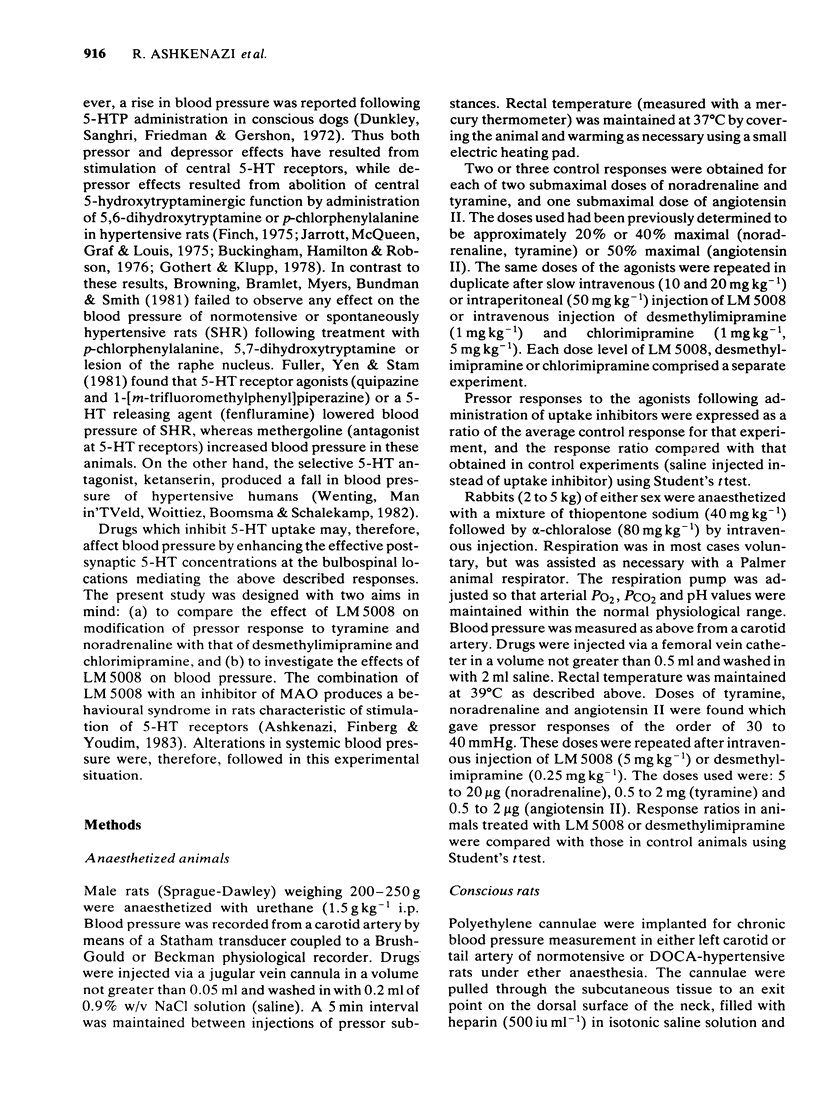

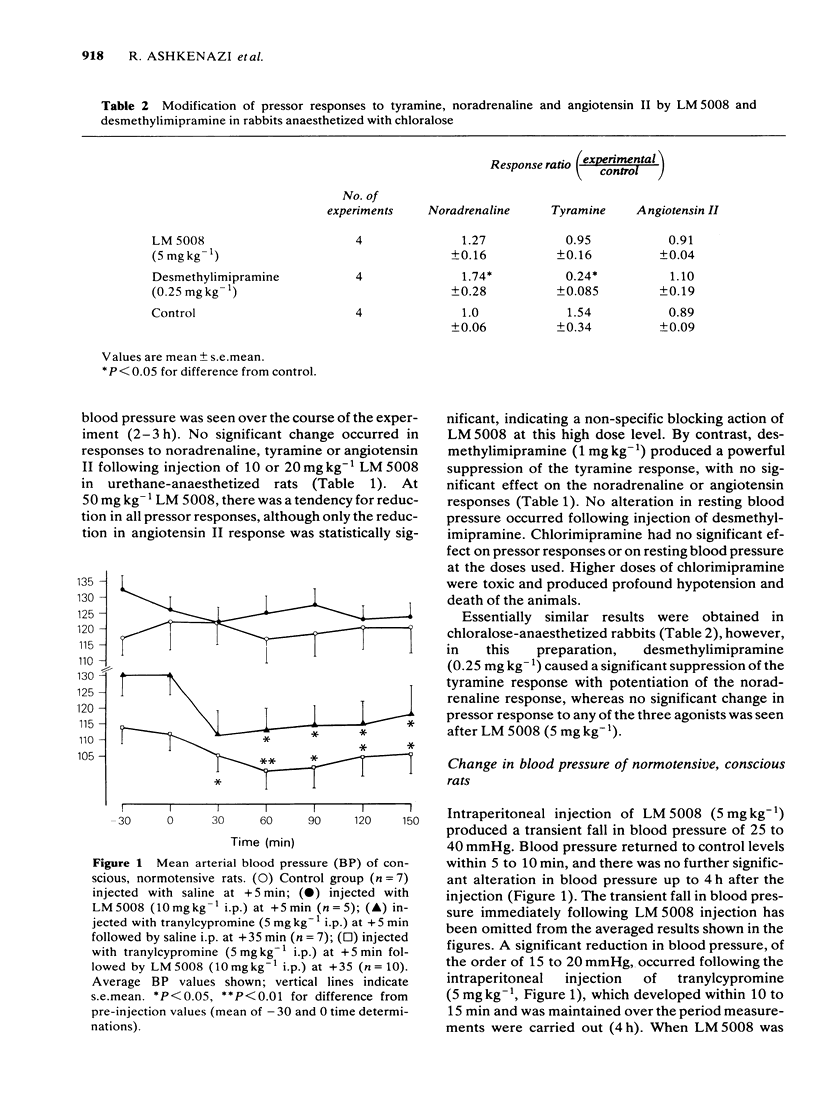
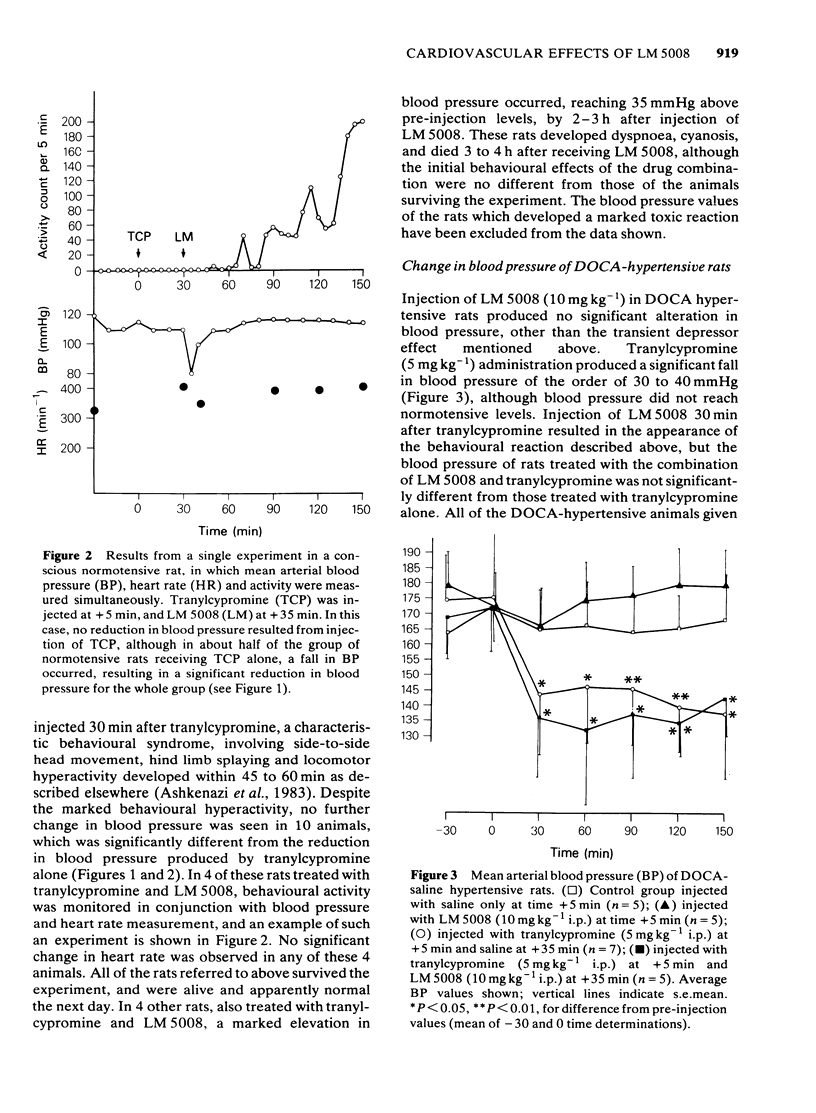
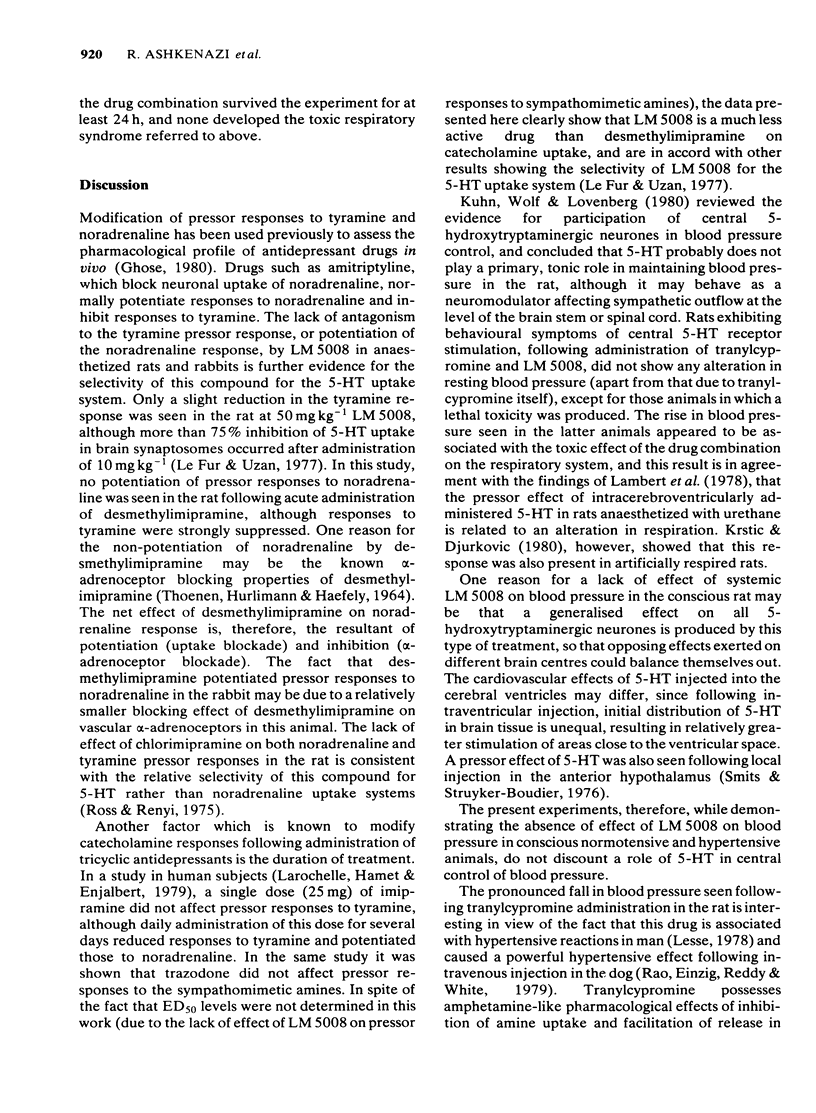
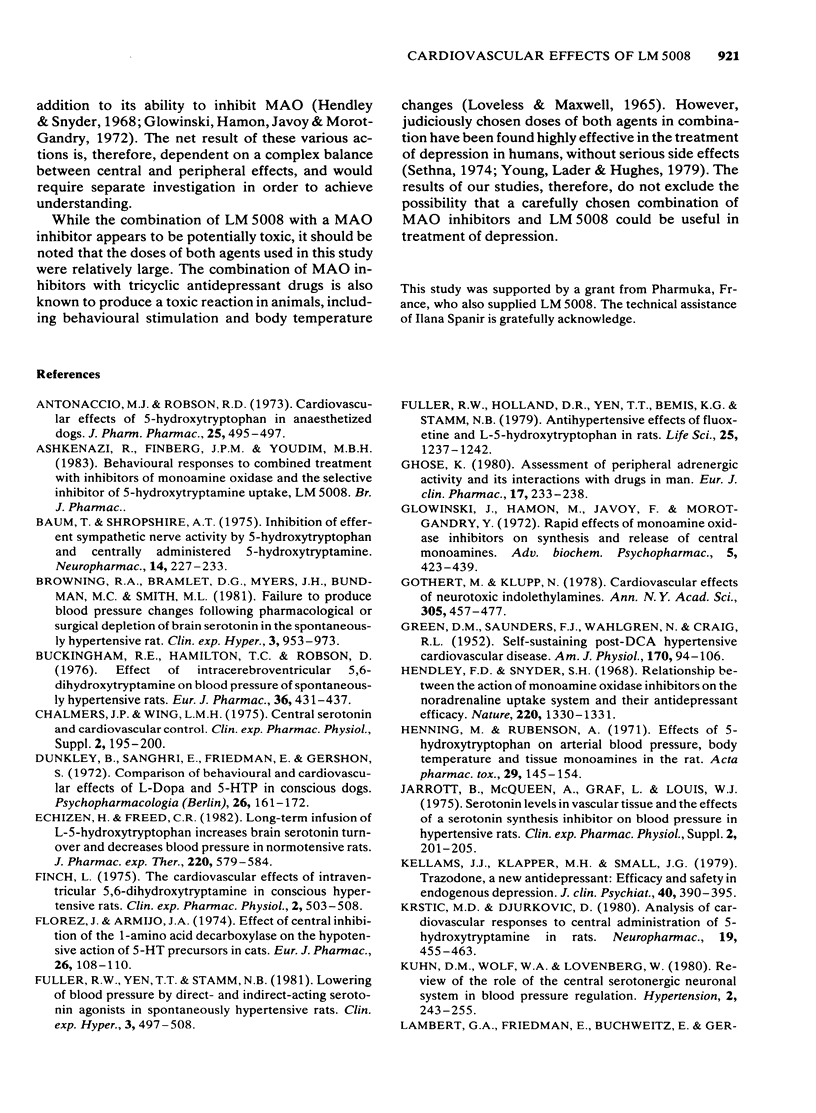

Selected References
These references are in PubMed. This may not be the complete list of references from this article.
- Antonaccio M. J., Robson R. D. Cardiovascular effects of 5-hydroxytryptophan in anaesthetized dogs. J Pharm Pharmacol. 1973 Jun;25(6):495–497. doi: 10.1111/j.2042-7158.1973.tb09142.x. [DOI] [PubMed] [Google Scholar]
- Baum T., Shropshire A. T. Inhibition of efferent sympathetic nerve activity by 5-hydroxytryptophan and centrally administered 5-hydroxytryptamine. Neuropharmacology. 1975 Mar;14(3):227–233. doi: 10.1016/0028-3908(75)90010-6. [DOI] [PubMed] [Google Scholar]
- Buckingham R. E., Hamilton T. C., Robson D. Effect of intracerebroventricular 5,6-dihydroxytryptamine on blood pressure of spontaneously hypertensive rats. Eur J Pharmacol. 1976 Apr;36(2):431–437. doi: 10.1016/0014-2999(76)90097-2. [DOI] [PubMed] [Google Scholar]
- Chalmers J. P., Wing L. M. Central serotonin and cardiovascular control. Clin Exp Pharmacol Physiol. 1975;Suppl 2:195–200. [PubMed] [Google Scholar]
- Dunkley B., Sanghvi I., Friedman E., Gershion S. Comparison of behavioral and cardiovascular effects of L-DOPA and 5-HTP in conscious dogs. Psychopharmacologia. 1972;26(2):161–172. doi: 10.1007/BF00422103. [DOI] [PubMed] [Google Scholar]
- Echizen H., Freed C. R. Long-term infusion of L-5-hydroxytryptophan increases brain serotonin turnover and decreases blood pressure in normotensive rats. J Pharmacol Exp Ther. 1982 Mar;220(3):579–584. [PubMed] [Google Scholar]
- Finch L. The cardiovascular effects of intraventricular 5,6-dihydroxytryptamine in conscious hypertensive rats. Clin Exp Pharmacol Physiol. 1975 Nov-Dec;2(6):503–508. doi: 10.1111/j.1440-1681.1975.tb01855.x. [DOI] [PubMed] [Google Scholar]
- Flórez J., Armijo J. A. Effect of central inhibition of the 1-amino acid decarboxylase on the hypotensive action of 5-HT precursors in cats. Eur J Pharmacol. 1974 Apr;26(1):108–110. doi: 10.1016/0014-2999(74)90080-6. [DOI] [PubMed] [Google Scholar]
- Fuller R. W., Holland D. R., Yen T. T., Bemis K. G., Stamm N. B. Antihypertensive effects of fluoxetine and L-5-hydroxytryptophan in rats. Life Sci. 1979 Oct 1;25(14):1237–1242. doi: 10.1016/0024-3205(79)90466-1. [DOI] [PubMed] [Google Scholar]
- Fuller R. W., Yen T. T., Stamm N. B. Lowering of blood pressure by direct- and indirect-acting serotonin agonists in spontaneously hypertensive rats. Clin Exp Hypertens. 1981;3(3):497–508. doi: 10.3109/10641968109033678. [DOI] [PubMed] [Google Scholar]
- GREEN D. M., SAUNDERS F. J., WAHLGREN N., CRAIG R. L. Self-sustaining, post-DCA hypertensive cardiovascular disease. Am J Physiol. 1952 Jul;170(1):94–106. doi: 10.1152/ajplegacy.1952.170.1.94. [DOI] [PubMed] [Google Scholar]
- Ghose K. Assessment of Peripheral adrenergic activity and its interactions with drugs in man. Eur J Clin Pharmacol. 1980 Apr;17(4):233–238. doi: 10.1007/BF00625795. [DOI] [PubMed] [Google Scholar]
- Göthert M., Klupp N. Cardiovascular effects of neurotoxic indolethylamines. Ann N Y Acad Sci. 1978 Jun 12;305:457–477. doi: 10.1111/j.1749-6632.1978.tb31541.x. [DOI] [PubMed] [Google Scholar]
- Hendley E. D., Snyder S. H. Relationship between the action of monoamine oxidase inhibitors on the noradrenaline uptake system and their antidepressant efficacy. Nature. 1968 Dec 28;220(5174):1330–1331. doi: 10.1038/2201330a0. [DOI] [PubMed] [Google Scholar]
- Henning M., Rubenson A. Effects of 5-hydroxytryptophan on arterial blood pressure, body temperature and tissue monoamines in the rat. Acta Pharmacol Toxicol (Copenh) 1971;29(23):145–154. doi: 10.1111/j.1600-0773.1971.tb00601.x. [DOI] [PubMed] [Google Scholar]
- Jarrott B., McQueen A., Graf L., Louis W. J. Serotonin levels in vascular tissue and the effects of a serotonin synthesis inhibitor on blood pressure in hypertensive rats. Clin Exp Pharmacol Physiol. 1975;Suppl 2:201–205. [PubMed] [Google Scholar]
- Kellams J. J., Klapper M. H., Small J. G. Trazodone, a new antidepressant: efficacy and safety in endogenous depression. J Clin Psychiatry. 1979 Sep;40(9):390–395. [PubMed] [Google Scholar]
- Krstić M. K., Djurković D. Analysis of cardiovascular responses to central administration of 5-hydroxytryptamine in rats. Neuropharmacology. 1980 May;19(5):455–463. doi: 10.1016/0028-3908(80)90053-2. [DOI] [PubMed] [Google Scholar]
- Kuhn D. M., Wolf W. A., Lovenberg W. Review of the role of the central serotonergic neuronal system in blood pressure regulation. Hypertension. 1980 May-Jun;2(3):243–255. doi: 10.1161/01.hyp.2.3.243. [DOI] [PubMed] [Google Scholar]
- Larochelle P., Hamet P., Enjalbert M. Responses to tyramine and norepinephrine after imipramine and trazodone. Clin Pharmacol Ther. 1979 Jul;26(1):24–30. doi: 10.1002/cpt197926124. [DOI] [PubMed] [Google Scholar]
- Le Fur G., Uzan A. Effects of 4-(3-indolyl-alkyl)piperidine derivatives on uptake and release of noradrenaline, dopamine and 5-hydroxytryptamine in rat brain synaptosomes, rat heart and human blood platelets. Biochem Pharmacol. 1977 Mar 15;26(6):497–503. doi: 10.1016/0006-2952(77)90324-0. [DOI] [PubMed] [Google Scholar]
- Lesse S. Tranylcypromine (Parnate)--a study of 1000 patients with severe agitated depressions. Am J Psychother. 1978 Apr;32(2):220–242. doi: 10.1176/appi.psychotherapy.1978.32.2.220. [DOI] [PubMed] [Google Scholar]
- Nava-Félix P., Hong E. Nature of the central serotonin receptors mediating hypotension. J Cardiovasc Pharmacol. 1979 Jul-Aug;1(4):461–466. doi: 10.1097/00005344-197907000-00008. [DOI] [PubMed] [Google Scholar]
- Rao G. H., Einzig S., Reddy K. R., White J. G. Tranylcypromine induced hypertension is not mediated by the inhibition of prostacyclin synthesis. Prostaglandins Med. 1979 Oct;3(4):201–210. doi: 10.1016/0161-4630(79)90081-8. [DOI] [PubMed] [Google Scholar]
- Ross S. B., Ogren S. O., Renyi A. L. (Z)-dimethylamino-1-(4-bromophenyl)-1-(3-pyridyl) propene (h 102/09), a new selective inhibitor of the neuronal 5-hydroxytryptamine uptake. Acta Pharmacol Toxicol (Copenh) 1976 Aug;39(2):152–166. doi: 10.1111/j.1600-0773.1976.tb03166.x. [DOI] [PubMed] [Google Scholar]
- Ross S. B., Renyi A. L. Tricyclic antidepressant agents. I. Comparison of the inhibition of the uptake of 3-H-noradrenaline and 14-C-5-hydroxytryptamine in slices and crude synaptosome preparations of the midbrain-hypothalamus region of the rat brain. Acta Pharmacol Toxicol (Copenh) 1975;36(Suppl 5):382–394. doi: 10.1111/j.1600-0773.1975.tb00806.x. [DOI] [PubMed] [Google Scholar]
- Sethna E. R. A study of refractory cases of depressive illnesses and their response to combined antidepressant treatment. Br J Psychiatry. 1974 Mar;124(0):265–272. doi: 10.1192/bjp.124.3.265. [DOI] [PubMed] [Google Scholar]
- Smits J. F., Struyker-Boudier H. A. Intrahypothalamic serotonin and cardiovascular control in rats. Brain Res. 1976 Jul 30;111(2):422–427. doi: 10.1016/0006-8993(76)90788-5. [DOI] [PubMed] [Google Scholar]
- Tadepalli A. S., Mills E., Schanberg S. M. Central depression of carotid baroreceptor pressor response, arterial pressure and heart rate by 5-hydroxytryptophan: influence of supracollicular areas of the brain. J Pharmacol Exp Ther. 1977 Aug;202(2):310–319. [PubMed] [Google Scholar]
- Waldmeier P. C., Baumann P. A., Maítre L. CGP 6085 A, a new, specific, inhibitor of serotonin uptake: neurochemical characterization and comparison with other serotonin uptake blockers. J Pharmacol Exp Ther. 1979 Oct;211(1):42–49. [PubMed] [Google Scholar]
- Wenting G. J., Man in 't Veld A. J., Woittiez A. J., Boomsma F., Schalekamp M. A. Treatment of hypertension with ketanserin, a new selective 5-HT2 receptor antagonist. Br Med J (Clin Res Ed) 1982 Feb 20;284(6315):537–539. doi: 10.1136/bmj.284.6315.537. [DOI] [PMC free article] [PubMed] [Google Scholar]
- Young J. P., Lader M. H., Hughes W. C. Controlled trial of trimipramine, monoamine oxidase inhibitors, and combined treatment in depressed outpatients. Br Med J. 1979 Nov 24;2(6201):1315–1317. doi: 10.1136/bmj.2.6201.1315. [DOI] [PMC free article] [PubMed] [Google Scholar]


